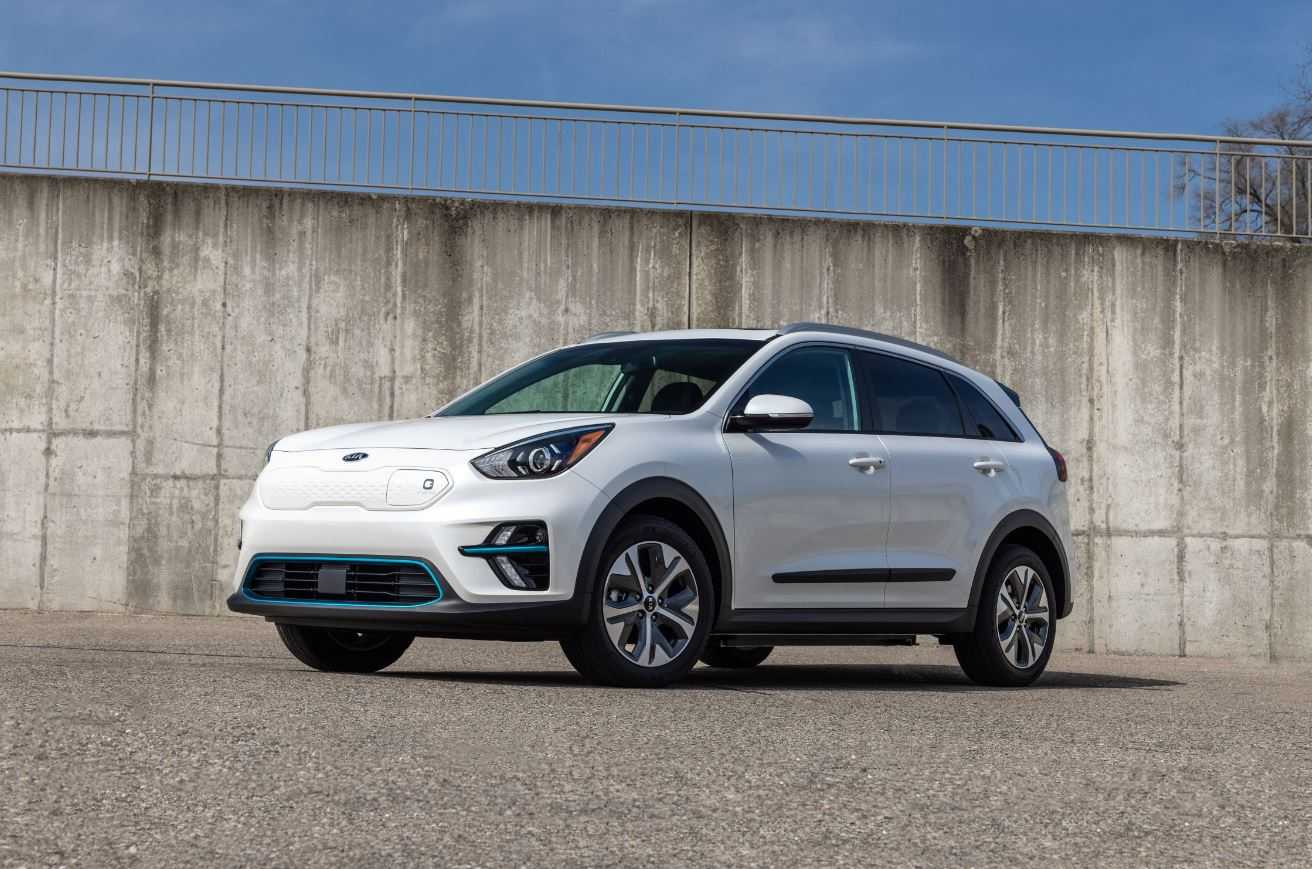Kia Niro EV 2021 Emergency User Manual
Introduction
The Niro EV 2021 is outfitted with a number of safety measures, including airbags, seat belt pretensioners, and a sturdy body structure, to assist lessen the impact and protect occupants in the event of a collision or emergency situation. The Niro EV 2021 may also include an emergency communication system that enables users to instantly contact emergency services in the event of a collision or other emergency. Emergency personnel may receive automatic crash notice from this device, making it easier for them to find and help the car.
It’s critical for drivers to become familiar with the Kia Niro EV 2021’s emergency features and systems. Drivers can respond to emergency circumstances more skill fully if they are aware of how these systems operate and what they are capable of, enhancing safety for all occupants. The emergency system in the Kia Niro EV 2021 is designed to ensure that passengers are safe and that assistance is available right away if needed.
What to Do in an Emergency
Road warning
When an emergency situation occurs while driving or when you park by the edge of the roadway, you must alert approaching or passing vehicles to be careful as they pass. For this, you should use the hazard warning flasher.
Hazard warning flasher
The hazard warning flasher serves as a warning to other drivers to exercise extreme caution when approaching, overtaking, or passing your vehicle.
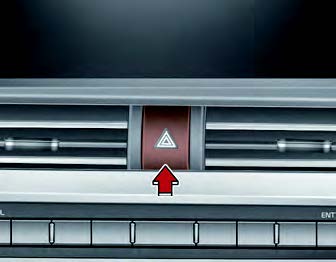
It should be used whenever emergency repairs are being made or when the vehicle is stopped near the edge of a roadway.
Depress the flasher switch with the POWER button in any position. The flasher switch is located in the center facia panel. All turn signal lights will flash simultaneously.
The hazard warning flasher operates whether your vehicle is running or not.
The turn signals do not work when the hazard flasher is on.
Care must be taken when using the hazard warning flasher while the vehicle is being towed.
IN CASE OF AN EMERGENCY WHILE DRIVING
If the engine stalls at a cross-road or crossing
If the engine stalls at a crossroad or crossing, set the shift lever in the N (Neutral) position and then push the vehicle to a safe place.
If you have a flat tire while driving
- Reduce your speed gradually, keeping a straight line.
- Move cautiously off the road to a safe place.
- Turn on your hazard warning flasher.
- Try to start the vehicle again. If your vehicle will not start, contact an authorized Kia dealer or seek other qualified assistance.
If the Vehicle Stalls at a crossroad or crossing
- If safe to do so, shift to the N (Neutral) position.
- Push the vehicle to a safe location.
If you have a flat tire while driving
- Take your foot off the accelerator pedal and let the vehicle slow down while driving straight ahead.
NOTICE
If there was a check engine light and loss of power or stall and if safe to do so wait at least 10 seconds to restart the vehicle after it stalls. This may reset the car so it will no longer run at low power (limp home) condition.
WARNING
Do not apply the brakes immediately to slow down the vehicle
- Use the paddle shifter (left side lever) to increase regenerative braking control.
- Do not or attempt to pull off the road as this may cause loss of vehicle control resulting in an accident.
- When the vehicle has slowed to such a speed that it is safe to do so, brake carefully and pull off the road.
- Drive off the road as far as possible and park on firm, level ground.
WARNING
If you are on a divided highway, do not park in the median area between the two traffic lanes.
- When the vehicle is stopped, press the hazard warning flasher but-ton, shift to P (Park), apply the parking brake, and place the POWER button in the OFF position.
- Have all passengers get out of the vehicle. Be sure they all get out on the side of the vehicle that is away from traffic.
- Follow the instructions provided later in this chapter.
If the vehicle will not start 12V battery
The vehicle may not start if the battery level is low.
Check the battery level by performing the following procedure.
- Be sure the shifter dial is in P (Park). The vehicle starts only when the shifter dial is in P (Park).
- Check the 12-volt battery connections to be sure they are clean and tight.
- Turn on the interior light. If the light dims or goes out when you operate the starter, the battery is drained.
Emergency (Engine and Tires)
- If your vehicle has an automatic transmission, be sure the shift lever is in N (Neutral) or P (Park) and the emergency brake is set.
- Check the battery connections to be sure they are clean and tight.
- Turn on the interior light. If the light dims or goes out when you operate the starter, the battery is discharged.
- Check the starter connections to be sure they are securely tightened.
- Do not push or pull the vehicle to start it. See instructions for “Jump starting”.
WARNING
Push / Pull start
Do not push or pull the vehicle to start it. Push or pull starting may cause the catalytic converter to overload and create a fire hazard.
If engine turns over normally but does not start
- Check the fuel level.
- With the ignition switch in the LOCK position, check all connectors at the ignition coils and spark plugs. Reconnect any that may be disconnected or loose.
- Check the fuel line in the engine compartment.
- If the engine still does not start, call an authorized Kia dealer or seek other qualified assistance.
WARNING
Do not push or pull the vehicle to start it. This could cause damage to your vehicle and/or to your body.
EMERGENCY STARTING
When the vehicle will not start 12V battery because of low battery power, you may need to jump start the vehicle.
Jump starting
Connect cables in numerical order and disconnect in reverse order.
Jump starting can be dangerous if done incorrectly. Therefore, to avoid harm to yourself or damage to your vehicle or battery, follow these jump starting procedures. If in doubt, we strongly recommend that you have a competent technician or towing service jump start your vehicle.
WARNING
Battery
Never attempt to check the electrolyte level of the battery as this may cause the battery to rupture or explode.
WARNING
Frozen batteries
Do not attempt to jump start the vehicle if the discharged battery is frozen or if the electrolyte level is low as the battery may rupture or explode.
WARNING
Electrolyte
- Do not charge or discharge the battery arbitrarily. It may lead to fault, electric shock or burns.
- Do not damage the battery in such ways as to drop, deform, impact, out or spear with a sharp object. It may cause electrolyte leakage or fire.
- Breakdown of the battery may lead to electrolyte leakage or flammable gas generation. Con-tact an authorized Kia dealer immediately.
- If electrolyte leaks out, avoid contact with eyes, skin or clothes. In event of accident, flush with water and get medical help immediately.
- Do not place the battery near open flame or incinerate. It may lead to fire or explosion.
Keep out of reach of children or animals.
Keep the battery away from moisture of liquid. Do not touch or use if liquids have been spilled on.
WARNING
Battery cables
Do not connect the jumper cable from the negative terminal of the booster battery to the negative terminal of the discharged battery, directly. This can cause the dis-charged battery to overheat, crack, and degrade.
Connect the jumper cable from the negative terminal of the booster battery to the chassis ground in the motor room.
WARNING
Sulfuric acid risk
When jump starting your vehicle be careful not to get acid on yourself, your clothing or on the vehicle. Automobile batteries contain sulfuric acid. This is poisonous and highly corrosive.
WARNING
Battery
Keep all flames or sparks away from the battery. The battery produces hydrogen gas which will explode if exposed to flame or sparks.
Jump starting procedure
- Make sure the booster battery is12-volt and that its negative terminal is grounded.
- If the booster battery is in another vehicle, do not allow the vehicles to come in contact.
- Turn off all unnecessary electrical loads.
- Connect the jumper cables in the exact sequence shown in the illustration. First connect one end of a jumper cable to the positive terminal of the discharged battery (1), then connect the other end to the positive terminal of the booster battery (2).
- Start vehicle with the booster battery and let it run, then start the vehicle with the discharged battery.
If the cause of your battery discharging is not apparent, you should have your vehicle checked by an authorized Kia dealer.
NOTICE
Make sure to connect one end of the jumper cable to the negative terminal of the booster battery, and the other end to a metallic point, far away from the battery.
Push-starting
Your vehicle equipped with reduction gear should not be push-started.
WARNING
Tow starting vehicle
Never tow a vehicle to start it. When the vehicle starts, the vehicle can suddenly surge forward and could cause a collision with the tow vehicle.
WARNING
Battery cables
Do not connect the jumper cable from the negative terminal of the booster battery to the negative terminal of the discharged battery. This can cause the discharged battery to overheat and crack, releasing battery acid.
Make sure to connect one end of the jumper cable to the negative terminal of the booster battery, and the other end to a metallic point, far away from the battery.
- Start the engine of the vehicle with the booster battery and let it run at 2,000 rpm, then start the engine of the vehicle with the discharged battery.
If the cause of your battery discharging is not apparent, you should have your vehicle checked by an authorized Kia dealer.
Push-starting
Your vehicle equipped with reduction gear should not be push-started.
WARNING
Tow starting vehicle
Never tow a vehicle to start it. When the vehicle starts, the vehicle can suddenly surge forward and could cause a collision with the tow vehicle.
TIRE PRESSURE MONITORING SYSTEM (TPMS)
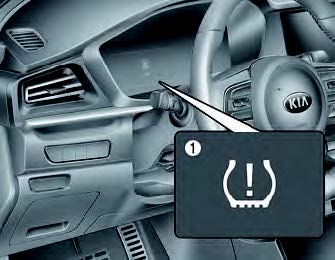
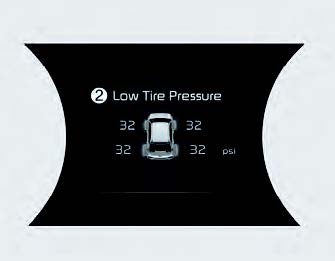
- Low tire pressure telltale /TPMS malfunction indicator
- Low tire pressure position telltale (Shown on the LCD display)
- The TPMS Malfunction Indicator remains illuminated after blinking for approximately 1 minute.
- The Low Tire Pressure LCD display remains illuminated.
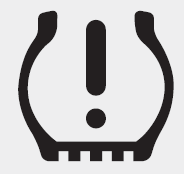 Low tire pressure telltale
Low tire pressure telltale
Low tire pressure position telltale
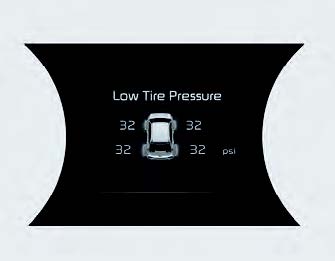
If the telltale illuminates, immediately reduce your speed, avoid hard cornering and anticipate increased stop-ping distances. You should stop and check your tires as soon as possible.
Inflate the tires to the proper pressure as indicated on the vehicle’s placard or tire inflation pressure label located on the driver’s side center pillar outer panel. If you cannot reach a service station or if the tire cannot hold the newly added air, replace the low pressure tire with the spare tire.
Then the TPMS malfunction indicator and the Low Tire Pressure telltale may turn on and illuminate after restarting and about 20 minutes of continuous driving before you have the low pressure tire repaired and replaced on the vehicle.
In winter or cold weather, the low tire pressure telltale may be illuminated if the tire pressure was adjusted to the recommended tire inflation pressure in warm weather. It does not mean your TPMS is malfunctioning because the decreased temperature leads to a proportional lowering of tire pressure.
When you drive your vehicle from a warm area to a cold area or from a cold area to a warm area, or the out-side temperature is greatly higher or lower, you should check the tire inflation pressure and adjust the tires to the recommended tire inflation pressure.
When filling tires with more air, conditions to turn off the low tire pressure telltale may not be met. This is because a tire inflator has a margin of error in performance. The low tire pressure telltale will be turned off if the tire pressure is above the recommended tire inflation pressure.
WARNING
Low pressure damage
Do not drive on low pressure tires. Significantly low tire pressure can cause the tires to over-heat and fail making the vehicle unstable resulting in increased braking distances and a loss of vehicle control.
 TPMS (Tire Pressure Monitoring System) malfunction indicator
TPMS (Tire Pressure Monitoring System) malfunction indicator
The low tire pressure telltale will illuminate after it blinks for approximate-ly one minute when there is a problem with the Tire Pressure Monitoring System. If the system is able to correctly detect an underinflation warning at the same time as system failure then it will illuminate both the TPMS malfunction and low tire pressure position telltales e.g. if Front Left sensor fails, the TPMS malfunction indicator illuminates, but if the Front Right, Rear Left, or Rear Right tire is under-inflated, the low tire pressure position telltales may illuminate together with the TPMS malfunction indicator.
Have the system checked by an authorized Kia dealer as soon as possible to determine the cause of the problem.
- The TPMS malfunction indicator may be illuminated if the vehicle is moving around electric power sup-ply cables or radios transmitters such as at police stations, government and public offices, broadcasting stations, military installations, airports, or transmitting towers, etc. This can interfere with normal operation of the Tire Pressure Monitoring System (TPMS).
- The TPMS malfunction indicator may be illuminated if snow chains are used or some separate electronic devices such as notebook computer, mobile charger, remote starter or navigation etc., are used in the vehicle. This can interfere with normal operation of the Tire Pressure Monitoring System (TPMS).
Tire replacement with TPMS
If you have a flat tire, the Low Tire Pressure telltale will come on. Have the flat tire repaired by an authorized Kia dealer as soon as possible or replace the flat tire with the spare tire.
CAUTION
Repair Agents
Never use a puncture-repairing agent not approved by Kia to repair and/or inflate a low pressure tire. The tire sealant not approved by Kia may damage the tire pressure sensor.
Each wheel is equipped with a tire pressure sensor mounted inside the tire behind the valve stem. You must use TPMS specific wheels. It is recommended that you always have your tires serviced by an authorized Kia dealer.
Even if you replace the low pressure tire with the spare tire, the Low Tire Pressure telltale will remain on until the low pressure tire is repaired and placed on the vehicle.
After you replace the low pressure tire with the spare tire, the TPMS malfunction indicator may illuminate after a few minutes because the TPMS sensor mounted on the spare wheel is not initiated.
Once the low pressure tire is reinflated to the recommended pressure and installed on the vehicle or the TPMS sensor mounted on the replaced spare wheel is initiated by an authorized Kia dealer, the TPMS malfunction indicator and the low tire pressure telltale will extinguish within a few minutes of driving.
If the indicator is not extinguished after a few minutes of driving, please visit an authorized Kia dealer.
If an original mounted tire is replaced with the spare tire, the TPMS sensor on the replaced spare wheel should be initiated and the TPMS sensor on the original mounted wheel should be deactivated. If the TPMS sensor on the original mounted wheel located in the spare tire carrier still activates, the tire pressure monitoring system may not operate properly. Have the tire with TPMS serviced or replaced by an authorized Kia dealer.
You may not be able to identify a low tire by simply looking at it. Always use a good quality tire pressure gauge to measure the tire’s inflation pressure. Please note that a tire that is hot (from being driven) will have a higher pressure measurement than a tire that is cold (from sitting stationary for at least 3 hours and driven less than 1 mile (1.6 km) during that 3 hour period).
Allow the tire to cool before measuring the inflation pressure. Always be sure the tire is cold before inflating to the recommended pressure.
A cold tire means the vehicle has been sitting for 3 hours and driven for less than 1 mile (1.6 km) in that 3 hour period.
Do not use any tire sealant if your vehicle is equipped with a Tire Pressure Monitoring System. The liquid sealant can damage the tire pressure sensors.
- The TPMS cannot alert you to severe and sudden tire damage caused by external factors such as nails or road debris.
- If you feel any vehicle instability, immediately take your foot off the accelerator, apply the brakes gradually and with light force, and slowly move to a safe position off the road.
NOTICE
Protecting TPMS
Tampering with, modifying, or disabling the Tire Pressure Monitoring System (TPMS) components may interfere with the system’s ability to warn the driver of low tire pressure conditions and/or TPMS malfunctions. Tampering with, modifying, or disabling the Tire Pressure Monitoring System (TPMS) components may void the warranty for that portion of the vehicle.
This device complies with Part 15 of the FCC rules.
Operation is subject to the following two conditions:
- This device may not cause harmful interference, and
- This device must accept any interference received, including interference that may cause undesired operation.
- Changes or modifications not expressly approved by the party responsible for compliance could void the user’s authority to operate the device.
IF YOU HAVE A FLAT TIRE Jack and tools
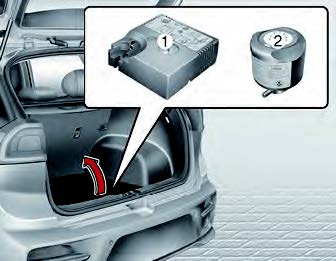
- Compressor
- Sealant bottle
For safe operation, carefully read and follow the instructions in this manual before use.
CAUTION
When two or more tires are flat, do not use the tire mobility kit because the one supplied canister of sealant in the Tire Mobility Kit is only enough sealant for one flat tire.
WARNING
Tire wall
Do not use the Tire Mobility Kit to repair large punctures or damage to the tire sidewalls. In these situations, the tire cannot be sealed completely and air will leak from the tire. This can result in tire failure.
WARNING
Have your tire repaired as soon as possible. The tire may loose air pressure at any time after inflating with the Tire Mobility Kit.
WARNING
Speed with temporary fix
Do not exceed a speed of 50 mph (80 km/h) when driving with a tire sealed with the Tire Mobility Kit. While driving, if you experience any unusual vibration, ride disturbance, or noise, reduce your speed and drive with caution until you can safely pull off to the side of the road.
Introduction
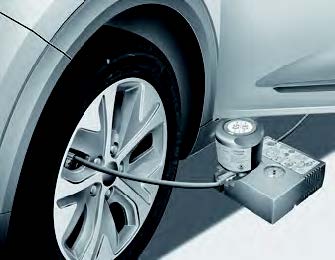
- With the Tire Mobility Kit you stay mobile even after experiencing a tire puncture.
The system of compressor and sealing compound effectively seals most punctures in a passenger car tire caused by nails or similar objects and reinflates the tire.
After you ensured that the tire is properly sealed you can drive cautiously on the tire at a max. speed of 50 mph (80 km/h) in order to reach a service station or tire dealer to have the tire replaced as soon as possible.
It is possible that some tires, especially with larger punctures or dam-age to the sidewall, cannot be sealed completely.
Air pressure loss in the tire may adversely affect tire performance.
For this reason, you should avoid abrupt steering or other driving maneuvers, especially if the vehicle is heavily loaded or if a trailer is in use.
The Tire Mobility Kit is not designed or intended as a permanent tire repair method and is to be used for one tire only.
This instruction shows you step by step procedure to temporarily seal the puncture. - Do not remove any foreign objects such as nails or screws that have penetrated the tire.
- Provided the car is outdoors, leave the vehicle ON ( indicator ON). Otherwise operating the compressor may eventually drain the car battery.
- Never leave the Tire Mobility Kit unattended while it is being used.
- Do not leave the compressor running for more than 10 min. at a time or it may overheat.
Do not use the Tire Mobility Kit if the ambient temperature is below -22 /F (-30 /C).
CAUTION
When repairing a flat tire with the Tire Mobility Kit (TMK), quickly remove the sealant on the tire pressure sensor and wheel. When installing the repaired tire and wheel, tighten the wheel nut to a torque value of 79~94 lbf6ft (11~13 kgf6m).
WARNING
Sealant
- Keep out of the reach of children.
- Avoid contact with eyes.
- Do not swallow.
WARNING
Do not use the tire sealant after the sealant has expired (i.e. past the expiration date on the sealant container). This can increase the risk of tire failure.
WARNING
- If the sealant gets on your skin, wash it with a large amount of water. If skin irritation continues, visit a doctor for examination.
- If the sealant gets into your eyes, raise your eyelid and wash for at least 15 minutes. If eye irritation continues, visit a doctor for examination.
- If you swallowed the sealant, wash the mouth and drink a large amount of water. However, do not give anything to an unconscious person and see the doctor immediately.
Exposure to the sealant for a long time may cause damage to the bodily tissues.
Components of the Tire Mobility Kit
Connectors, cable and connection hose are stored in the compressor housing.
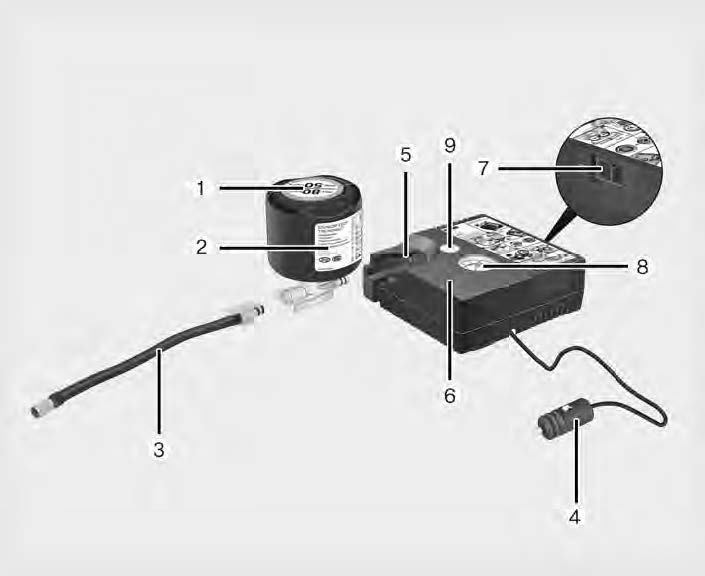
- Speed restriction label
- Sealant bottle and label with speed restriction
- Filling hose from sealant bottle to wheel
- Connectors and cable for the power outlet direct connection
- Holder for the sealant bottle
- Compressor
- On/off switch
- Pressure gauge for displaying the tire inflation pressure
- Button for reducing tire inflation pressure
WARNING
Before using the Tire Mobility Kit, follow the instructions on the seal-ant bottle.
Remove the label with the speed restriction from the sealant bottle and apply it to the steering wheel. Please note the expiration date on the sealant bottle.
NOTICE
Before using the tire repair kit, please read carefully the instruction attached on the sealant bottle. Detach the speed limit label on the sealant case and put it on a highly visible place. Always drive within the speed limit.
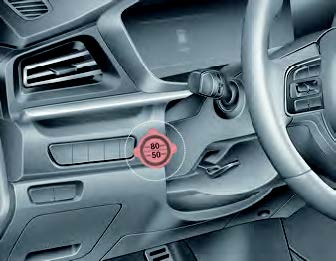
Using the Tire Mobility Kit
Carefully follow below steps.
- Shake the sealant bottle.
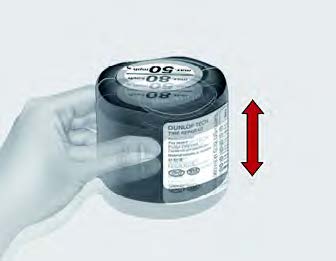
- Connect the filling hose (3) onto the connector of the sealant bottle (2).
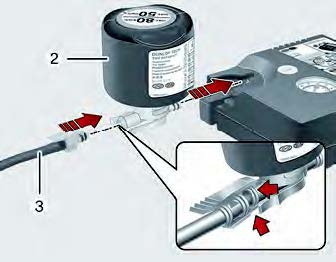
- Ensure that button (9) on the compressor is not pressed.
- Unscrew the valve cap from the valve of the defective wheel and screw filling hose (3) of the seal-ant bottle onto the valve.
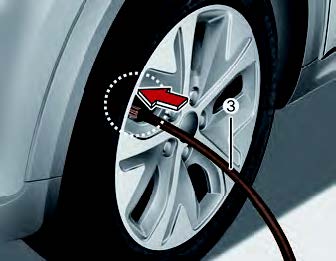
- Insert the sealant bottle into the housing of the compressor (5) so that the bottle is upright.
NOTICE
If a visable foreign object has punctured the tire, do not remove it before using Tire Mobility Kit.
NOTICE If the sealant is injected when the tire air pressure injection valve and sealant injection hose are not fully interlocked, the sealant may over-flow and clog the valve.
If the sealant is injected when the tire air pressure injection valve and sealant injection hose are not fully interlocked, the sealant may over-flow and clog the valve. - Ensure that the compressor is switched off, position 0.
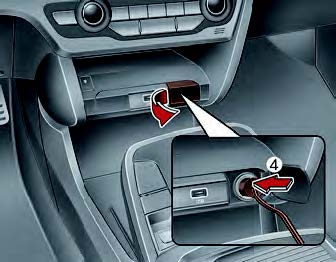
- Connect between compressor and the vehicle power outlet (4) using the cable and connectors.
- With the POWER button ON, switch on the compressor and let it run for approximately 5~7 minutes to fill the sealant up to cold tire recommended pressure.
(refer to “Tires and wheels” on page 9-4). The inflation pressure of the tire after filling is unimportant and will be checked/corrected later. Be careful not to overinflate the tire and stay away from the tire when filling it.
WARNING
Tire pressure
Do not attempt to drive your vehicle if the tire pressure is below 29 psi (200 kPa). This could result in an accident due to sudden tire failure. - Switch off the compressor.
- Detach the hoses from the seal-ant bottle connector and from the tire valve.
- Return the Tire Mobility Kit to its storage location in the vehicle.
- WARNING
Carbon monoxide
Carbon monoxide poisoning and suffocation is possible if the vehicle is left running in a poorly ventilated or unventilated location (such as inside a building).
Distributing the sealant
After putting sealant into the tire, it is necessary to drive the vehicle so that the sealant becomes evenly distributed inside the tire.
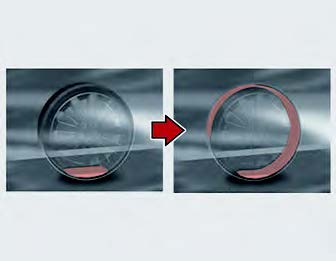
- Immediately drive approximately 4~6 miles (7~10 km or, about 10 min) to evenly distribute the seal-ant in the tire.
Do not exceed a speed of 50 mph (80 km/h). If possible, do not fall below a speed of 12 mph (20 km/h).
While driving, if you experience any unusual vibration, ride disturbance or noise, reduce your speed and drive with caution until you can safely pull off of the side of the road.
CAUTION
When you use the Tire Mobility Kit, the tire pressure sensors and wheel may be stained by sealant. There-fore, remove the tire pressure sensors and wheel stained by the sealant and have your vehicle inspected by an authorized Kia dealer.
Checking the tire inflation pressure
After driving briefly so as to distribute the sealant throughout the inside of the tire, you should check the tire inflation pressure.
- After driving approximately 4~6 miles (7~10 km or about 10 min), stop at a safe location.
- Connect the filling hose (3) of the compressor (clip mounted side) directly and then connect the filling hose (3) (opposite side) to the tire valve.

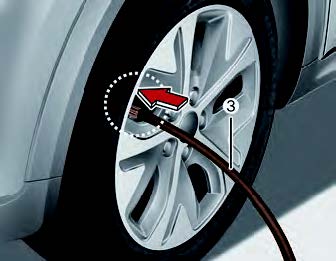
- Connect between compressor and the vehicle power outlet using the cable and connectors.
- Adjust the tire inflation pressure to the cold tire recommended pressure as indicated on the vehicle’s placard or tire inflation pressure label located on the driver’s side center pillar outer panel. (In this owner’s manual, refer to
“Tires and wheels” To increase the inflation pressure, switch on the compressor, position I. To check the current inflation pressure setting, briefly switch off the compressor.
CAUTION
Tire pressure sensor
When you use the Tire Mobility Kit with a sealant that is not approved by Kia, the tire pressure sensors may be damaged by sealant. The sealant on the tire pressure sensor and wheel should be removed when you replace the tire with a new one and the tire pressure sensors should be inspected at an authorized dealer.
What to do in an emergency
Technical data
The specifications of the Tire Mobility Kit are as follows.
| System Voltage | DC 12 V | |
| Working Voltage | DC 10~15 V | |
| Amperage rating | MAX. 15 A 0 1 A
(at DC 12 V operation) |
|
| Suitable for use at temperatures | -22~+158 /F (-30~+70 /C) | |
| Max. working pressure | 87 psi (6 bar) | |
| Size | Compressor | 6.3 X 5.9 X 2.2 in
(161 X 150 X 55.8 mm) |
| Sealant bottle | w 3.3 X 4.1 in
(w 85 X 104 mm) |
|
| Compressor weight | 1.4400.06 lbs
(655030 g) |
|
| Sealant volume | 18.3 cu in (300 ml) | |
- * Sealant and spare parts can be obtained and replaced at an authorized vehicle or tire dealer. Empty sealant bottles may be disposed of at home. Liquid residue from the sealant should be dis-posed of by your vehicle or tire dealer or in accordance with local waste disposal regulations.
- Towing
If emergency towing is necessary, we recommend having it done by an authorized Kia dealer or a commercial tow-truck service. - Towing service
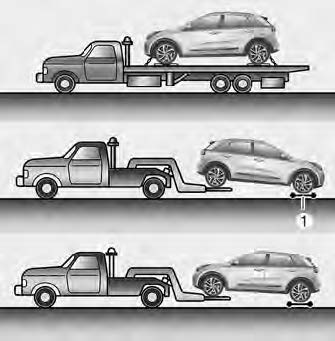
- Proper lifting and towing procedures are necessary to prevent damage to the vehicle. The use of wheel dollies (1) or flatbed is recommended.
On FWD vehicles, it is acceptable to tow the vehicle with the rear wheel on the ground (without dollies) and the front wheels off the ground. If any of the loaded wheels or suspension components are damaged or the vehicle is being towed with the front wheels on the ground, use a towing dolly under the front wheels. When being towed by a commercial tow truck and wheel dollies are not used, the front of the vehicle should always be lifted, not the rear.
WARNING
Side and curtain Air bag
If your vehicle is equipped with side and curtain air bag, place the POWER button in OFF or ACC when the vehicle is being towed.
The side and curtain air bag may deploy when the POWER button is ON, and the rollover sensor detects the situation as a rollover.
CAUTION
Towing


- Do not tow the vehicle backwards with the front wheels on the ground as this may cause damage to the vehicle.
- Do not tow with sling-type equipment. Use wheel lift or flatbed equipment.
WARNING
- If you tow the vehicle while the front wheels are touching the ground, the vehicle motor may generate electricity and the motor components may be dam-aged or a fire may occur.
- When a vehicle fire occurs due to the battery, there is a risk of a second fire. Contact the fire department when towing the vehicle.
Towing without Wheel Dollies when using a Towing Service
When towing your vehicle in an emergency without wheel dollies:
- While depressing the brake pedal shift to the N (Neutral) position and turn the vehicle off. The POWER button will be in the ACC position.
- Place the shifter dial in N (Neutral).
- Release the parking brake.
CAUTION
Towing gear position
Failure to shift to N (Neutral) may cause internal damage to the vehicle.
Using removable towing hook (if equipped)

Front
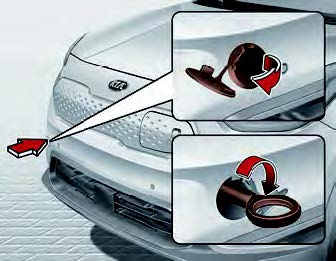
Rear
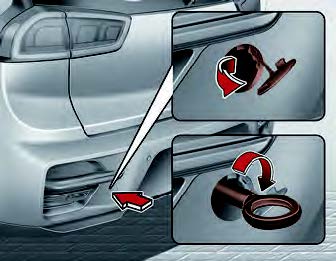
- Open the liftgate, and remove the towing hook from the tool case.
- Remove the hole cover pressing the upper (front) / lower (rear) part of the cover on the bumper.
- Install the towing hook by turning it clockwise into the hole until it is fully secured.
- Remove the towing hook and install the cover after use.
Emergency towing
If towing service is not available in an emergency, your vehicle may be temporarily towed using a cable or chain secured to the emergency towing hook under the front (or rear) of the vehicle.
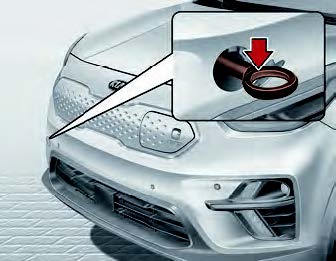
Rear
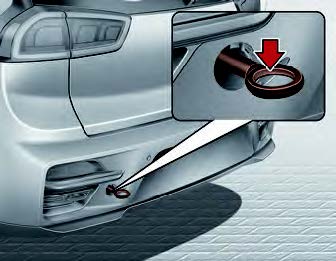
If towing is necessary, have it done by an authorized Kia dealer or a commercial tow truck service.
Use extreme caution when towing the vehicle. A driver must be in the vehicle to steer it and operate the brakes.
Towing in this manner may be done only on hard-surfaced roads for a short distance and at low speed. Also, the wheels, axles, power train, steering and brakes must all be in good condition.
- Do not use the tow hooks to pull a vehicle out of mud, sand or other conditions from which the vehicle cannot be driven out under its own power.
- Avoid towing a vehicle heavier than the vehicle doing the towing.
- The drivers of both vehicles should communicate with each other frequently.
CAUTION
Using a portion of the vehicle other than the tow hooks for towing may damage the body of your vehicle.
- Attach a towing strap to the tow hook.
- Use only a cable or chain specifically intended for use in towing vehicles. Securely fasten the cable or chain to the towing hook pro-vided.
- Accelerate or decelerate the vehicle in a slow and gradual manner while maintaining tension on the tow rope or chain to start or drive the vehicle, otherwise tow hooks and the vehicle may be damaged.
- Before emergency towing, check if the hook is not broken or damaged.
Fasten the towing cable or chain securely to the hook.
Do not jerk the hook. Apply it steadily and with even force.
To avoid damaging the hook, do not pull from the side or at a vertical angle. Always pull straight ahead. - Use a towing strap less than 16 feet (5 m) long. Attach a white or red cloth (about 12 inches (30 cm) wide) in the middle of the strap for easy visibility.

- Drive carefully so that the towing strap is not loosened during towing.
The driver must be in the vehicle for steering and braking operations when the vehicle is towed and passengers other than the driver must not be allowed to be on board.
WARNING
Emergency Towing Precautions Use extreme caution when towing the vehicle.
- Avoid sudden starts or erratic driving maneuvers which would place excessive stress on the emergency towing hook and towing cable or chain. The hook and towing cable or chain may break and cause serious injury or damage.
- If the disabled vehicle is unable to be moved, do not forcibly continue the towing. We recommend that you contact an authorized Kia dealer or a commercial tow
truck service for assistance.
Tow the vehicle as straight ahead as possible.
Keep away from the vehicle during towing.
Emergency towing precautions
- While depressing the brake pedal shift to the N (Neutral) position and turn the vehicle off. The POWER button will be in the ACC position.
- Release the parking bake.
- Press the brake pedal with more force than normal since you will have reduced brake performance.
- More steering effort will be required because the power steering system will be disabled.
- If you are driving down a long hill, the brakes may overheat and brake performance will be reduced. Stop often and let the brakes cool off.
- If the car is being towed with all four wheels on the ground, it can be towed only from the front. Be sure that the reduction gear is in neutral. Be sure the steering is unlocked by placing the POWER button in the ACC position. A driver must be in the towed vehicle to operate the steering and brakes.
- To avoid serious damage to the reduction gear, limit the vehicle speed to 10 mph (15 km/h) and drive less than 1 mile (1.5 km) when towing. (for Reduction gear vehicle.)
CAUTION
To avoid damage to your vehicle and vehicle components when towing:
- Always pull straight ahead when using the towing hooks. Do not pull from the side or at a vertical angle.
- Do not use the towing hooks to pull a vehicle out of mud, sand or other conditions from which the vehicle cannot be driven out under its own power.
NOTICE
Before towing, check the reduction gear for fluid leaks under your vehicle. If the reduction gear fluid is leaking, a flatbed equipment or towing dolly must be used.
If an accident occurs
If an accident occurs, stay calm and take the following precautions.
WARNING
High voltage components
- For your safety, do not touch high voltage cables, connectors and package modules. High voltage components are orange in color.
- Exposed cables or wires may be visible inside or outside of the vehicle. Never touch the wires or cables, because an electrical shock, an injury, or a death may occur.
NOTICE
Any gas or electrolyte leakage from your vehicle is not only poisonous but also flammable. Upon witnessing one of those, make sure your car is parked in a safe area away from any roads, open the windows, and maintain a safe distance away from the vehicle. Immediately contact an authorized Kia dealer and advise them that an electric vehicle is involved.
- If you need towing, refer to “Towing”
When the vehicle is severely damaged, remain a safe distance of 50 feet (15 meter) or more What to do in an emergency between your vehicle and other vehicles/flammables.
If a fire occurs, immediately call emergency services (911) and advise the emergency responders that an electric vehicle is involved.
WARNING
Submersion in water
Do not touch your vehicle if it has been submerged in water. The high-voltage battery may cause shock or may catch fire. Immediately contact the authorities and advise them of the condition of your vehicle and that an electric vehicle is involved.
FAQs
To safeguard occupants in the event of an accident or emergency, the Kia Niro EV 2021 is fitted with numerous airbags, including front, side, and curtain airbags.
The Kia Niro EV 2021 normally has many airbags, including curtain airbags on the sides of the cabin, side airbags for the front seats, and front airbags for the driver and front passenger.
The Kia Niro EV 2021 might come with an automatic crash notification or emergency communication system that can immediately contact emergency authorities in the case of an accident.
In the event of an emergency, the Kia Niro EV 2021 may contain a button or function that allows users to immediately reach emergency services or roadside help.
To enable a speedy and secure evacuation from the vehicle in an emergency, the Kia Niro EV 2021 might contain a system that automatically opens the doors.
In an emergency, the Kia Niro EV 2021 may automatically turn on the danger lights to warn other motorists and increase visibility.
The Kia Niro EV 2021’s integrated emergency roadside assistance service may or may not be available, depending on the area and particular features it has.
The Kia Niro EV 2021 might come with features like Autonomous Emergency Braking (AEB), which can recognize impending crashes and immediately apply the brakes to lessen or prevent an accident.
In the case of an accident, the Kia Niro EV 2021’s emergency communication system may be able to automatically alert emergency services.
While the Kia Niro EV 2021 might have a few safety features, it’s vital to remember that they might not have been added with emergencies involving submersion in water in mind. In such circumstances, it is essential to seek external assistance and evacuate right away.
The Kia Niro EV 2021 might come with advanced driver assistance systems (ADAS) that can recognize possible emergencies and issue alerts or take corrective action, including Lane Departure Warning (LDW) or Forward Collision Warning (FCW).
Depending on the features and connection choices offered, the infotainment system of the Kia Niro EV 2021 may give users access to emergency services or applications.
In most cases, you may get in touch with Kia roadside help in an emergency by utilizing the contact information supplied. This information can be obtained in the owner’s manual, on the company’s website, or through customer care channels.
It’s crucial to retain composure, keep the car under control, and drive safely when there is an emergency. Learn how to use the emergency features of the Kia Niro EV 2021 and become familiar with them. Always put your own safety first, abide by local laws, and know what to do in an emergency.
The Kia Niro EV 2021 may or may not be equipped with extra safety features or equipment. For compatible choices and appropriate installation, speak with a Kia dealership or authorized repair facility.
Useful Links
View Full User Guide: Kia Niro EV 2021| Auto User Guide
Download Manuals: Owner’s Manuals and Documents | Kia

